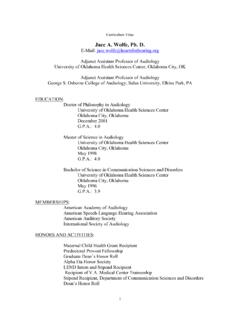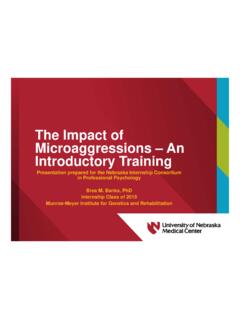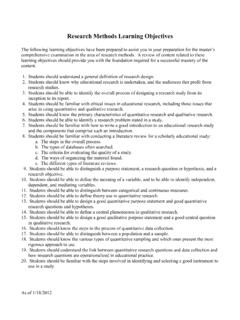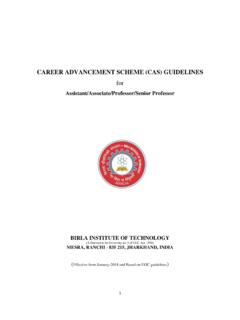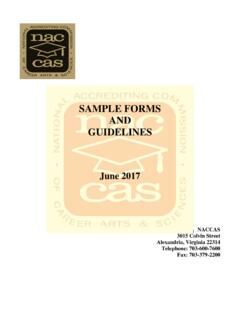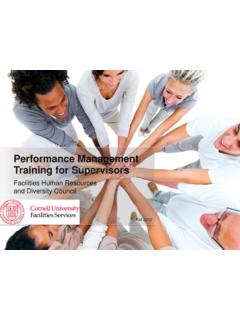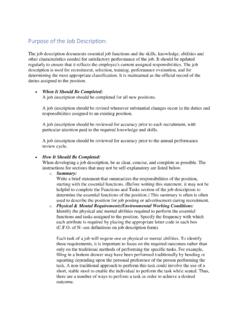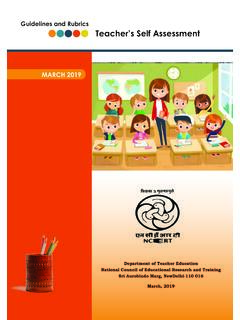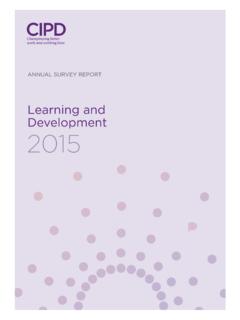Transcription of Faculty Workload Guidelines - College of Education and ...
1 Faculty Workload Guidelines Preamble The purpose of this policy statement is twofold. First, it provides guidance to the Faculty , Chairs and the Dean in making assignments of Workload to Faculty . Second, it assists in an effort to equitably distribute Faculty responsibilities across Faculty in the College over time. It is acknowledged that there is rich diversity across units and individual Faculty members in the College , and that simplistic approaches to equity in Workload will not work. Through time these Guidelines should assist all involved to make more equitable Workload decisions through discussion, negotiation, and resource allocation. That is, this policy and its implementation shall assure that full-time Faculty members have comparable total effort, although individual distributions of teaching, service, outreach, and research may vary across Faculty members.
2 This document is based on the University requirement that a Faculty member s responsibilities be allocated across various apportionment categories (please see the Appendix). According to the Board of Regents (BOR) Bylaws the terms of this apportionment are to be reviewed periodically and may be changed by mutual consent. Within the terms of this general apportionment of responsibilities and subject to a Faculty member's general area of competence, the details of a Faculty member's specific assignments or job description should be subject to joint consultation but are to be determined by the department chair, unit administrator, or director concerned (UNL General Principles of Faculty evaluation : Process, Criteria, and Standards-subsection on Criteria).
3 Definitions Faculty Workload refers to all Faculty activities that contribute to the accomplishment of unit-related activities and responsibilities: research/creative activity, teaching, service, outreach, and extension (where appropriate). As such, Faculty Workload may be conceptualized at both the individual level and the unit level. Apportionment refers to the specified division among teaching, research, service, extension, and administrative responsibilities making up a Faculty member's University appointment (BOR Bylaws, ). Faculty are defined by the College s bylaws. Principles underlying CEHS Workload policy 1. The policy reflects the CEHS mission and values. 2. The policy involves communication among all parties invested in the appointment.
4 3. The policy encompasses the total Faculty role. 4. The policy needs to be flexible and responsive to the needs of individuals and units (over time, over career stage, across the mission, across individuals). 5. The policy allows for differentiated staffing. 6. The Workload policy informs an individual s performance evaluation , but it is not the same as evaluation . The former adopts a prospective perspective, 2 whereas the latter is retrospective. 7. The policy takes into account a unit goals/needs/mission as well as an individual Faculty member s goals/needs. 8. The policy needs to be capable of addressing multiple timeframes (semester, annual , and multiyear). 9. Each unit is responsible for contributing to the mission areas: research, teaching, service, and outreach.
5 10. The Workload policy supports, but does not replace judgment in determining the distribution of work for individuals or among groups of Faculty over time. 11. It is the chair s responsibility to strive for equity in Faculty total effort over time. 12. A Faculty member s Workload will be consistent with tenure and/or promotion and annual evaluation Guidelines . Principles underlying apportionments 1. The total apportionment across all areas will total 100%; areas are defined in the Appendix. 2.. no special adjustments of norms for units or individuals shall alter the University's fundamental criterion: all Faculty members must do scholarly or professional work that demonstrates creative achievement (UNL General Principles of Faculty evaluation : Process, Criteria, and Standards: Criteria).
6 3. Anyone with a teaching apportionment must teach a minimum of 1 course per academic year. 4. It is .. generally expected that a Faculty member's apportionment of responsibilities shall be relatively stable from year to year, unless there is reasonable justification for change (BOR Bylaws, ). 5. Appropriate management of apportionments by administrators seeks to best serve student interests, Faculty interests, and meet departmental responsibilities by maximizing the application of Faculty expertise. 6. A change in the apportionment of duties cannot be made unilaterally by administrators or by Faculty members. 7. The specific apportionment of a Faculty member's responsibilities shall be reviewed periodically.
7 8. Either the Faculty member or the responsible unit administrator may initiate discussions of changes in apportionment. 9. In the process of any such discussions, both the Faculty member and the unit administrator shall act in good faith to reach a mutual agreement. 10. There will be a written statement by the chair of the agreed upon apportionment. 11. All individuals are expected to perform department and/or College service. 12. External funding is considered to be part of load unless there is other significant effort in progress. The determination of whether such effort is considered significant is made by the relevant administrator(s) in collaboration with the Faculty member. Note: If the Faculty member and the unit administrator are unable to reach mutual agreement with respect to changes in apportionment of the Faculty member's responsibilities, the unresolved issues between them shall be expeditiously reviewed and 3 decided by an elected Faculty committee of the Faculty member's tenure home College (see Regential Bylaws ).
8 Guidelines : The metrics below are used to determine a Faculty member s apportionment values. Teaching Courses Guideline 1: A three-credit course constitutes a 10% apportionment for the academic year. Each department is to define this standard based on their individual circumstances ( , the typical enrollment, whether this refers to graduate or undergraduate level, etc.). Advising Guideline 2: Three to ten fulltime graduate students constitutes a 5% apportionment for the academic year. Each department will determine the valuing of specific factors ( , nonthesis versus thesis students, doctoral student supervision, doctoral committee chair, doctoral committee member, doctoral committee Reader, masters/EdS committee chair, masters/EdS committee member, endorsements, etc.)
9 And their interactions. Research/Scholarship/Creative Activity Guideline 3: Research, scholarship, and creative activity will have a focus within the Unit, Department, or College mission and that this body of work is recognized by professional peers. Guideline 4: A record of outside peer-reviewed or professionally-reviewed publications or creative exhibitions, that on average, results in one to two refereed publications/creative exhibitions per year (in addition to other publications/creative exhibitions that may not be refereed, involvement in obtaining patents and technology transfer, etc.), and on average, at least one national professional meeting presentation per year will constitute a 30% apportionment.
10 Service There are two facets to Service: Service to the institution and service to the discipline. Service to the Institution: This category reflects service or leadership roles at the Department, College , Cooperative Extension, Division, Institute, Campus, or University level. It represents active participation on committees that focus on issues or directives of the institution, which includes assuming a leadership role on one or more committees or actively participating on one or more committees per year. For senior Faculty service would also include formal mentoring of junior Faculty . Departmental and College citizenship is expected of all Faculty . Service to the Discipline: This category reflects service involving active participation in professional or governmental organizations at the local, state, regional, national, or international level.

